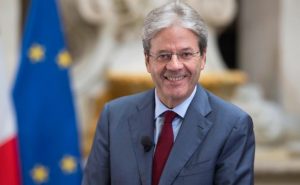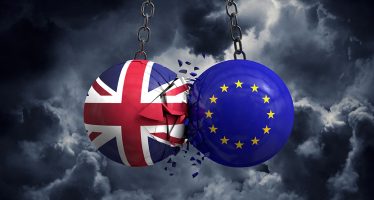Commissioner Gentiloni on EU Economy: Andante Ma Non Troppo

EU Commissioner for Economy: Paolo Gentiloni. Source: Tiberio Barchielli
The V-shaped economic recovery expected to unfold next year is merely an illusion sourced from wishful thinking. Yesterday, EU Commissioner for Economy Paolo Gentiloni warned of a double-dip recession and said the European Commission mulls an extension by at least a year – and possibly running far into 2022 – of the ‘general escape clause’ which temporarily lifts the ceiling on deficit spending and permissible debt levels as stipulated in the 1992 Maastricht Treaty. According to Gentiloni, a quick and full economic recovery is not in the books. He advised member states to keep fiscal support measures in place for ‘as long as needed’.
Initially overwhelmed by the viral outbreak – and swiftly side-tracked by member states invoking their sovereign right to tackle the emergency without deferring to Brussels – the European Union has been behind the pandemic’s curve since early March, relegated to reactive rather than proactive policy initiatives. Accepting a fait accompli, the European Commission, the union’s executive branch, mumbled its blessing of member states ignoring fiscal guidelines as most governments embarked on a panic-driven spending spree to keep their locked down economies from crashing.
The European Fiscal Board (EFB), an advisor to the commission, earlier suggested that fiscal constraints should only be reactivated once economic output has reached pre-pandemic levels – something not likely to happen before the end of 2022. In its latest forecast, published last week, the European Commission expects the bloc’s GDP to shrink by 7.4 percent this year, followed in 2021 by a strong but far from exuberant rebound of 4.1 percent.
Bounce Blues
Gentiloni said that the surprisingly strong second wave, and the restrictions on mobility it necessitated, interrupted a much more promising and robust economic bounce: “Growth will return next year, but it will be another year before the European economy comes close to regaining its pre-pandemic level.” Gentiloni hopes that the €750 billion recovery fund currently being hammered out may add another two percent or so to EU GDP whilst it is active. Disbursements are set to start early next year.
EU watchers in Brussels caution that the reimposition of fiscal rules is likely to be contested by several member states even after the corona scare has abated. Under the Maastricht Treaty, the maximum allowable debt-to-GDP ratio is 60 percent and fiscal deficits may not exceed 3 percent of GDP.
These restrictions proved exceptionally painful in the wake of the 2009-10 financial crisis and ushered in a ‘lost decade’ of austerity, resulting in low growth and high youth unemployment. Last month, the EFB urged member states to re-examine the Stability and Growth Pact and in particular its public debt ceiling which, it argues, may disincentivise public investment. Gentiloni agrees that reform is needed although he insists that a clearly delineated fiscal framework is still required to move towards a convergence of economic policies.
Steady as She Goes
On Wednesday, ECB President Christine Lagarde signalled that she is not about to disengage as she raised expectations that the bank will yet again expand its Pandemic Emergency Purchase Programme (PEPP) which has already scooped up €640 billion in bonds. The ECB’s Targeted Longer-Term Refinancing Operations (TLTROs), which provided commercial lenders with more than €1.5 trillion in credit at rates as low as minus one percent, is also set for a fresh injection of cash, adding another €500 billion to the tally.
According to Lagarde, ‘all options remain on the table’. She assured that PEPP and TLTROs have proven their effectiveness ‘in the current environment’. Lifting the veil on the outcome of the monetary policy ‘recalibration’ exercise undertaken last month, the ECB president ensured her audience that the bank is likely to use both instruments as its main tools. Though Lagarde did not rule out a reduction in the ECB’s deposit rate – already a record-low minus 0.5 percent – she didn’t mention the possibility in yesterday’s presentation, leading market watchers to believe that the bank will leave the interest rate unchanged.
In her presentation, Lagarde emphasised that all sectors of the economy need to have the confidence that ‘exceptionally favourable’ financing conditions will remain in place for as long as needed: “Demand weakness and economic slack are weighing in on inflation, which is expected to remain in negative territory for longer than previously thought.” Lagarde dismissed the notion that the ECB’s loose monetary policy helps create a vast universe of ‘zombie’ companies tapping the bank’s elixir of life to stay upright: “Concerns about ‘zombification’ or impending creative destruction are misplaced, especially if a vaccine is now in sight.”
Lockdown Light
Tracking some of the more esoteric economic indicators in an attempt to gauge the depth of the second corona dip, analysts suspect that the impact of the lockdown light imposed in most EU member states may not be as severe as initially feared. Data on truck haulage miles, travel to and from offices, and retail store traffic obtained from geolocation statistics complied by Google show that mobility has barely been affected as most people go about their usual business with the exception of visits to restaurants and entertainment venues.
According to ING economist Bert Colijn, governments have learned from the first lockdown and avoided the wholesale closure of the economy by focussing instead on the maintenance of social distancing rules. Colijn called the current restrictions the ‘lockdown of fun’ and said that the largest impact on the economy is suffered by countries such as France and Ireland that have closed down all retail outlets deemed non-essential.
In Germany, work-related mobility has not been affected by the new restrictions whilst in France the drop was less than half the one recorded in March. Economic researchers broadly agree that Q4 economic output is likely to fall by no more than four percent compared to the previous quarter, delaying but not derailing the economic recovery.
Real-time transportation tracker Shippeo found the European supply chain running at 94 percent of capacity. Deutsche Bank economist Stefan Schneider, quoted in the Financial Times, said that manufacturing has been helped by relatively strong overseas demand as supply chains recovered and borders remain open.
The Freightos-Baltic Index of global freight rates, a gauge for trade volumes, has been rising steadily since early October, indicating strong demand for container shipping as well as a more pronounced divergence between the manufacturing and services sectors with the former steaming ahead relatively unimpeded and the latter struggling to regain momentum.
You may have an interest in also reading…
Sanctions Against Russia Resemble a Boxing Match
The economic sanctions against Russia announced last week by the US and Europe are having a profound impact on the
Johan Thijs and KBC’s Transformative Support of Werchter Boutique Festival
Under the leadership of CEO Johan Thijs, KBC Group has been a steadfast supporter of Belgium’s Werchter Boutique Festival, blending
Brexit Nears, Hedge Funds Flip Sides, and IMF Urges Spending
The yield on the benchmark 10-year German bund this week dipped to minus 0,63 percent as investors scrambled for safety



















































































